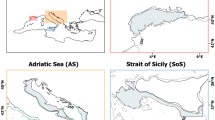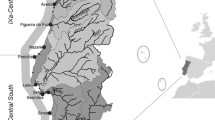Abstract
Effect of wind stress on the annual catch of Japanese anchovy Engraulis japonicus off northwestern Kyushu for the period between 1963 and 2009 was investigated. Regime shift analysis detected several step changes in catch and environmental variables. Since the mid-1980s, the anchovy catch in the coastal fishery zones has declined, while the catch in the offshore zone has increased. The decline of catch in the coastal zones showed a significant correlation with the long-term variations in prevailing north-northeastward wind stress over the Goto-Nada Sea during spring spawning season. The results indicated that weakened north-northeastward winds caused the recent low recruitment of anchovy through low levels of wind-induced eggs and larval transport from the offshore spawning ground to the coastal nursery areas, resulting in the potential shift of nursery area to the northwestern offshore region. Thus, as well as the growth-favorable ambient temperature, transport process would play a key role on long-term fluctuations in anchovy abundance in these coastal seas.














Similar content being viewed by others
References
Chavez FP, Ryan J, Lluch-cota SE, Niquen CM (2003) From anchovies to sardines and back: multidecadal change in the Pacific Ocean. Science 217:217–221
Zenitani H, Kimura R (2007) Elemental analysis of otoliths of Japanese anchovy: trial to discriminate between Seto Inland Sea and Pacific stock. Fish Sci 73:1–8
Tanaka H, Ohshimo S, Takagi N, Ichimaru T (2010) Investigation of the geographical origin and migration of anchovy Engraulis japonicus in Tachibana Bay, Japan: a stable isotope approach. Fish Res 102:217–220
Kawasaki T (1983) Why do some pelagic fishes have wide fluctuations in their numbers? Biological basis of fluctuation from the viewpoint of evolutionary ecology. FAO Fish Rep 291:1065–1080
Lluch-Belda D (1989) World-wide fluctuations of sardine and anchovy stocks: the regime problem. S Afr J Mar Sci pp 195–205
Schwartzlose R, Alheit J, Bakun A (1999) Worldwide large-scale fluctuations of sardine and anchovy populations. S Afr J Mar Sci pp 37–41
Takasuka A, Oozeki Y, Aoki I (2007) Optimal growth temperature hypothesis: why do anchovy flourish and sardine collapse or vice versa under the same ocean regime? Can J Fish Aquat Sci 64:768–776
Takasuka A, Oozeki Y, Kubota H (2008) Multi-species regime shifts reflected in spawning temperature optima of small pelagic fish in the western North Pacific. Mar Ecol Prog Ser 360:211–217
Yamashita K (1984) Relation between the distribution of Sardine eggs and larvae and fishing condition of “Shirasu” in the Goto-Nada. Bull Nagasaki Pre Inst Fish 10:7–17
Takagi N, Kenji M, Hideaki N (2009) Structure and variation of the north to northeastward current observed on the continental margin of the Amakusa-nada and southern part of Goto-Nada through winter to spring. Bull Jpn Soc Fish Oceanogr 73:172–180
Iseki K, Kiyomoto Y (1997) Distribution and settling of Japanese anchovy (Engraulis japonicus eggs at the spawning ground off Changjiang River in the East China Sea. Fish Oceanogr 6:205–210 (in Japanese)
Kozasa E (1975) Distribution of plankton in the western seas of Kyushu [Japan], 1: amounts of chlorophyll and zooplankton in Amakusa-nada and Tachibana-Bay in winter, 1974. Bull Seikai Reg Fish Res Lab 13:1–13 (in Japanese)
Gaines S, Bertness M (1992) Dispersal of juveniles and variable recruitment in sessile marine species. Nature 360:579–580
Cowen RK, Sponaugle S (2009) Larval dispersal and marine population connectivity. Ann Rev Marine Sci 1:443–466
Kuroda H, Oshimo S, Yasuda T (2012) Stock assessment and evaluation for Tsushima Warm Current stock of Japanese anchovy (fiscal year 2011). In Marine Fisheries Stock Assessment and Evaluation for Japanese Waters (Fiscal year 2011/2012), pp 785–803. Fisheries Agency and Fisheries Research Agency of Japan. p 1735 (in Japanese)
Kuwaoka M (1976) Recent fluctuation of the fisheries aspect of anchovy in the coast of the Southern Nagasaki Prefecture. Bull Nagasaki Pref Inst Fish 2:25–32 (in Japanese)
Ogawa N (1976) Mechanisms of migration of anchovy, Engraulis japonica, towards the shore in Goto-nada and Tachibana Bay, western Kyushu (Japan). Bull Seikai Reg Fish Res Lab (Japan) 48:1–22 (in Japanese)
Hiyama Y, Yoda M, Ohshimo S (2002) Stock size fluctuations in chub mackerel (Scomber japonicus) in the East China Sea and the Japan/East Sea. Fish Oceanogr 11:347–353
Ohshimo S, Tanaka H, Hiyama Y (2009) Long-term stock assessment and growth changes of the Japanese sardine (Sardinops melanostictus) in the Sea of Japan and East China Sea from 1953 to 2006. Fish Oceanogr 18:346–358
Peck MA, Reglero P, Takahashi M, Catalán IA (2013) Life cycle ecophysiology of small pelagic fish and climate-driven changes in populations. Prog Oceanogr 116:220–245
Rodionov S, Overland J (2005) Application of a sequential regime shift detection method to the Bering Sea ecosystem. ICES J Mar Sci 62:328–332
Miyazawa Y, Zhang R, Guo X, Tamura H, Ambe D, Lee J-S, Okuno A, Yoshinari H, Setou T, Komatsu K (2009) Water mass variability in the western North Pacific detected in a 15-year eddy resolving ocean reanalysis. J Oceanogr 65:737–756
Warner JC (2005) Numerical modeling of an estuary: a comprehensive skill assessment. J Geophys Res 110:C05001
Kondo J (1975) Air-sea bulk transfer coefficients in diabetic conditions. Bound Layer Meteor 9:91–112
Tian Y, Kidokoro H, Watanabe T (2006) Long-term changes in the fish community structure from the Tsushima Warm Current region of the Japan/East Sea with an emphasis on the impacts of fishing and climate regime shift over the last four decades. Prog Oceanogr 68:217–237
Borja A, Uriarte A, Valencia V, Motos L (1996) Relationships between anchovy (Engraulis encrasicolus L.) recruitment and the environment in the Bay of Biscay. Sci Mar 60:179–192
Nielsen E, Bagge O, MacKenzie BR (1998) Wind-induced transport of plaice (Pleuronectes platessa) early life-history stages in the Skagerrak-Kattegat. J Sea Res 39:11–28
Hinrichsen H (2001) Testing the larval drift hypothesis in the Baltic Sea: retention versus dispersion caused by wind-driven circulation. ICES J Mar Sci 58:973–984
Linnane A, James C, Middleton J et al (2010) Impact of wind stress anomalies on the seasonal pattern of southern rock lobster (Jasus edwardsii) settlement in South Australia. Fish Oceanogr 19:290–300
Nakata H, Hirano T (1988) Wind effects on the transport of red sea bream larvae from a coastal spawning ground adjacent to Shijiki Bay. Nippon Suisan Gakkaishi 54:1545–1552
Churchill JH, Runge J, Chen C (2011) Processes controlling retention of spring-spawned Atlantic cod (Gadus morhua) in the western Gulf of Maine and their relationship to an index of recruitment success. Fish Oceanogr 20:32–46
Chen C, Chiu T (2003) Early life history traits of Japanese anchovy in the Northeastern Waters of Taiwan, with reference to larval transport. Zool Stud 42:248–257
Takasuka A, Aoki I (2006) Environmental determinants of growth rates for larval Japanese anchovy Engraulis japonicus in different waters. Fish Oceanogr 15:139–149
Takeshige A, Takahashi T, Nakata H, Kimura S (2013) Long-term trends in sea surface temperature in coastal water in relation to large-scale climate change: a case study in Omura Bay, Japan. Cont Shelf Res 66:73–82
Aiken CM, Navarrete SA, Pelegrí JL (2011) Potential changes in larval dispersal and alongshore connectivity on the central Chilean coast due to an altered wind climate. J Geophys Res 116:1–14
Lie H, Cho C, Lee J (1998) Separation of the Kuroshio water and its penetration onto the continental shelf west of Kyushu. J Geophys Res 103:2963–2976
Iversen S, Zhu D, Johannessen A, Toresen R (1993) Stock size, distribution and biology of anchovy in the yellow Sea and East China Sea. Fish Res 16:147–163
Oshimo S (1996) Acoustic estimation of biomass and school character of anchovy Engraulis japonicus in the East China Sea and the yellow Sea. Fish Sci 62:344–349
Author information
Authors and Affiliations
Corresponding author
Rights and permissions
About this article
Cite this article
Takeshige, A., Miyake, Y., Nakata, H. et al. Effect of wind stress on the catch of Japanese anchovy Engraulis japonicus off northwestern Kyushu, Japan. Fish Sci 79, 989–998 (2013). https://doi.org/10.1007/s12562-013-0672-z
Received:
Accepted:
Published:
Issue Date:
DOI: https://doi.org/10.1007/s12562-013-0672-z




